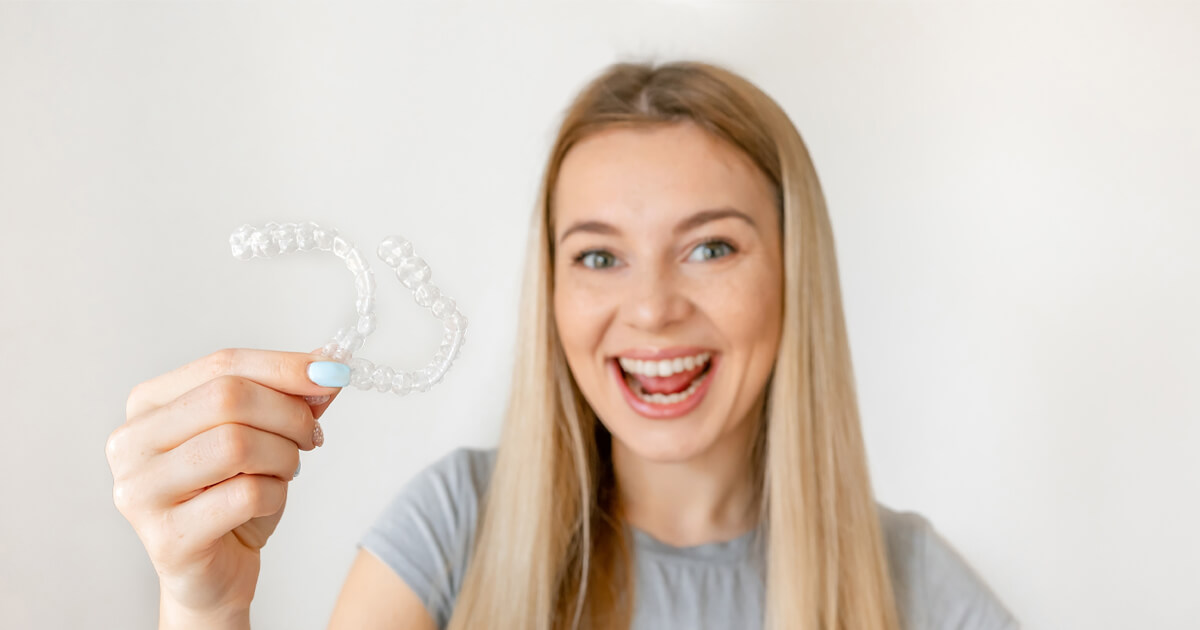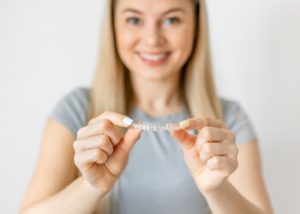Does Invisalign Hurt? Know What To Do To Manage Discomfort

Invisalign aligners are generally considered more comfortable than traditional metal braces, but pain is a relative concept, and some patients have a higher pain threshold than others. If you are considering Invisalign treatment, the research indicates that any pain and discomfort are most likely to be experienced in the first week after having them fitted. In this article, we will explore the question ‘does Invisalign hurt’ and what you can do to manage discomfort.
What are Invisalign Aligners?
Invisalign aligners are orthodontic appliances made out of clear plastic. They are fitted over the front of your teeth and apply pressure to move misaligned teeth into the correct positions.
Does Invisalign Hurt?
It’s quite possible to experience discomfort when you have Invisalign treatment because the aligners are applying pressure that moves your teeth into position. The level of pain experienced is highly subjective and differs between patients.
What To Expect After Invisalign Aligners Are Fitted
Some studies indicate that the highest level of discomfort is experienced in the first week after fitting. A study conducted in 2005 found that 83% of patients grew accustomed to their aligners afterwards. Interestingly, the same study also discovered that 35% of patients didn’t experience any pain at all.
Of the patients who did report pain during Invisalign treatment, 44% indicated that the pain was associated with chewing.
Risk Factors For Experiencing Pain During Invisalign Treatment
Some people are more susceptible to pain than others. Some of the risk factors for experiencing a higher degree of discomfort include
- A low pain tolerance
- Tooth sensitivity
- The presence of gingivitis or sensitive gums
Understanding How The Invisalign Cycle Works
Invisalign aligners are usually changed every two weeks. Unlike traditional metal braces, which need to be adjusted as your teeth shift, when you have aligners, you simply swap them for a new set.
This means you could experience some discomfort for two to three days every time you start wearing new aligners. It’s highly likely that the further you progress into your treatment cycle, the more you will get used to the new sensation and the more desensitised you will become.
Traditional Braces vs Invisalign Aligners
Studies have indicated that patients who wear traditional metal braces are likely to experience greater pain and discomfort than those who opt for aligners. Furthermore, patients who have metal braces are more likely to need pain medication than those using aligners. Fortunately, the research also indicates that patients from both groups tend to adjust to discomfort within approximately three months.
Invisalign is also less likely to cause abrasions to your gums as there are no wires or metal brackets to agitate your soft tissue.
Where Are You Most Likely To Feel Discomfort From Braces?
Braces and aligners may cause discomfort in
- Your jaw
- Your teeth
- Your tongue
Adjusting To The Discomfort: Treating Pain
 While some patients may not need any treatment for pain, others may find relief from the following:
While some patients may not need any treatment for pain, others may find relief from the following:
- Over-the-counter medications
- Eating soft foods after a new set of aligners
- Leaving your aligners in for extended periods of time gives your mouth a chance to get used to them. Remember that your trays should be worn for a minimum of 22 hours a day in order to meet your treatment goals.
When Should You Consult Your Dentist?
If you find the pain worsens or doesn’t improve within a week of installing your new trays, it’s a good idea to speak to your dentist about it.
Even though Invisalign aligners may cause temporary discomfort, they do an effective job at straightening crooked teeth, and it’s important that you wear them for the recommended amount of time every day. To find out more about ‘does Invisalign hurt’ or whether aligners could straighten your teeth, please contact one of our five conveniently located dental clinics to book your appointment.
Note: Any surgical or invasive procedure carries risks. Before proceeding, you should seek a second opinion from an appropriately qualified health practitioner.
References
How does Invisalign treatment work?
https://www.invisalign.com/how-invisalign-works
Does Invisalign Hurt?
https://www.healthline.com/health/dental-and-oral-health/does-invisalign-hurt
